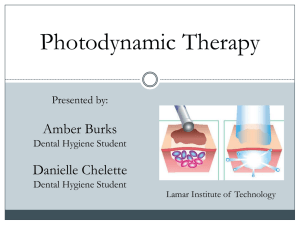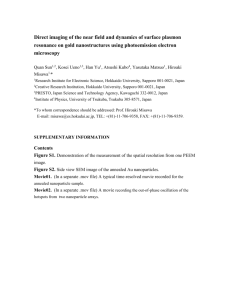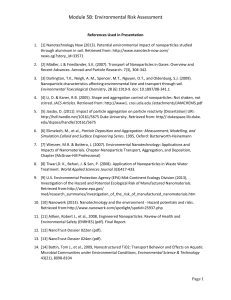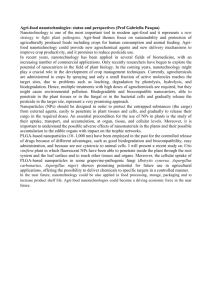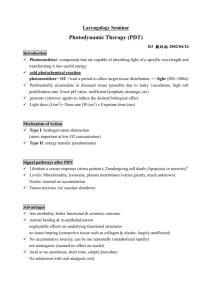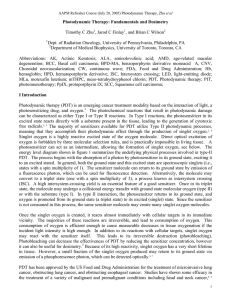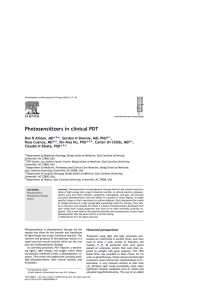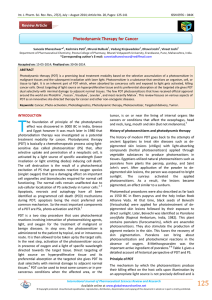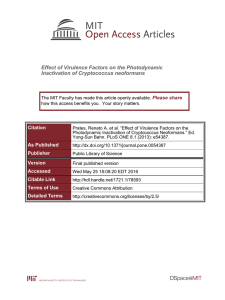Nanoparticle Self-lighting Photodynamic Therapy
advertisement
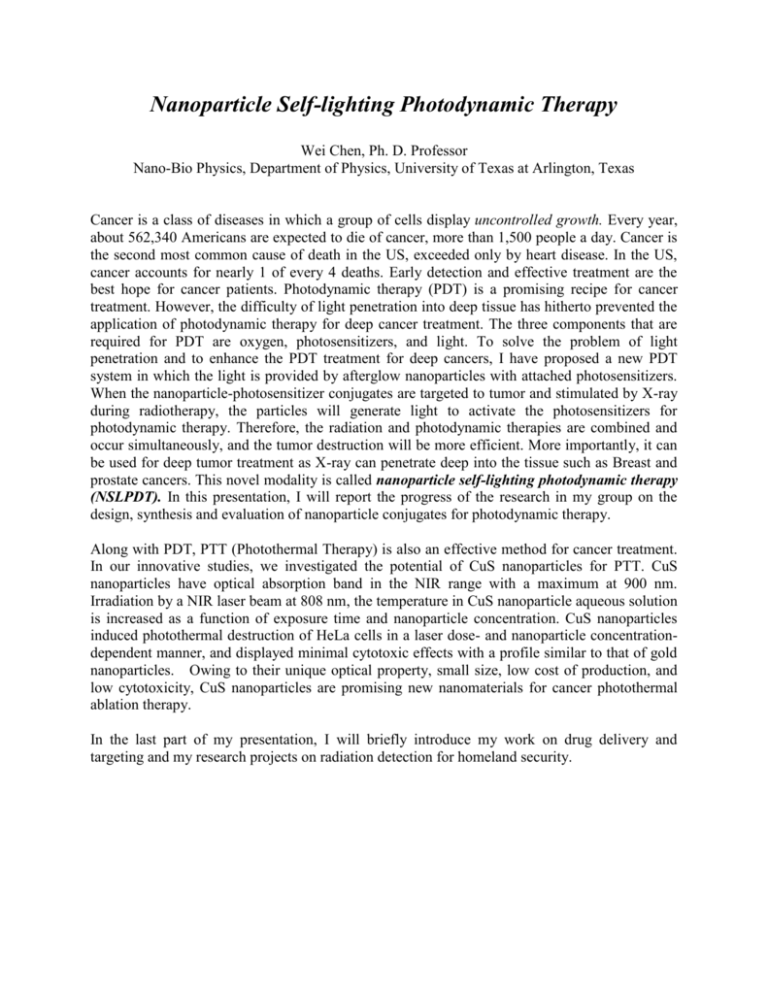
Nanoparticle Self-lighting Photodynamic Therapy Wei Chen, Ph. D. Professor Nano-Bio Physics, Department of Physics, University of Texas at Arlington, Texas Cancer is a class of diseases in which a group of cells display uncontrolled growth. Every year, about 562,340 Americans are expected to die of cancer, more than 1,500 people a day. Cancer is the second most common cause of death in the US, exceeded only by heart disease. In the US, cancer accounts for nearly 1 of every 4 deaths. Early detection and effective treatment are the best hope for cancer patients. Photodynamic therapy (PDT) is a promising recipe for cancer treatment. However, the difficulty of light penetration into deep tissue has hitherto prevented the application of photodynamic therapy for deep cancer treatment. The three components that are required for PDT are oxygen, photosensitizers, and light. To solve the problem of light penetration and to enhance the PDT treatment for deep cancers, I have proposed a new PDT system in which the light is provided by afterglow nanoparticles with attached photosensitizers. When the nanoparticle-photosensitizer conjugates are targeted to tumor and stimulated by X-ray during radiotherapy, the particles will generate light to activate the photosensitizers for photodynamic therapy. Therefore, the radiation and photodynamic therapies are combined and occur simultaneously, and the tumor destruction will be more efficient. More importantly, it can be used for deep tumor treatment as X-ray can penetrate deep into the tissue such as Breast and prostate cancers. This novel modality is called nanoparticle self-lighting photodynamic therapy (NSLPDT). In this presentation, I will report the progress of the research in my group on the design, synthesis and evaluation of nanoparticle conjugates for photodynamic therapy. Along with PDT, PTT (Photothermal Therapy) is also an effective method for cancer treatment. In our innovative studies, we investigated the potential of CuS nanoparticles for PTT. CuS nanoparticles have optical absorption band in the NIR range with a maximum at 900 nm. Irradiation by a NIR laser beam at 808 nm, the temperature in CuS nanoparticle aqueous solution is increased as a function of exposure time and nanoparticle concentration. CuS nanoparticles induced photothermal destruction of HeLa cells in a laser dose- and nanoparticle concentrationdependent manner, and displayed minimal cytotoxic effects with a profile similar to that of gold nanoparticles. Owing to their unique optical property, small size, low cost of production, and low cytotoxicity, CuS nanoparticles are promising new nanomaterials for cancer photothermal ablation therapy. In the last part of my presentation, I will briefly introduce my work on drug delivery and targeting and my research projects on radiation detection for homeland security. Dr. Wei Chen is a full professor of Nano-Bio Physics at the Physics Department, The University of Texas at Arlington. He received his Ph. D. in Chemistry from Peking University, Beijing, China. In 2000, Dr. Chen joined Nomadics, where he serves as a senior and leading scientist in Nanotechnology. In 2006, he joined UTA as an assistant professor in Nano-Bio Physics and was promoted to associate professor in 2011 and a full professor in 2013. Dr. Chen pioneered the photostimulated luminescence of nanoparticles and the nanoparticle self-lighting photodynamic therapy for cancer treatment. He has been funded by National Natural Science Foundation of China, President Special Funds of Chinese Academy of Science, NSF, NIH, DHS, DOE, Army Medical and Air Force Office, DTRA and Industry. He has 7 US patents granted and 7 US patents pending. He has co-authored more than 200 journal publications, 4 invited review articles, 7 book chapters and one edited book. So far, Dr. Chen’s publications have been cited more than 7000 times and his H-index is 43. He serves as Editor-inChief for Reviews in Nanoscience and Nanotechnology, American editor for the Journal of Nanoscience and Nanotechnology and the associate editor for Journal of Biomedical Nanotechnology published by American Scientific Publishers. 陈伟教授简介 陈伟(Wei Chen)博士系国际著名纳米药物和癌 症纳米技术专家,德克萨斯大学(The University of Texas at Arlington, UTA)物 理系纳米生物物理专业终身教授,UTA纳米技术联合安全研究中心(the Center for Security Advances Via Nano-Technology)主任,生物医学纳米技术杂志( Journal of Biomedical nanotechnology )副主编,美国科学出版社(American Scientific Publishers, California)主编,纳米科学与技术评论杂志(Reviews in Nanoscience and Nanotechnology)主编。
